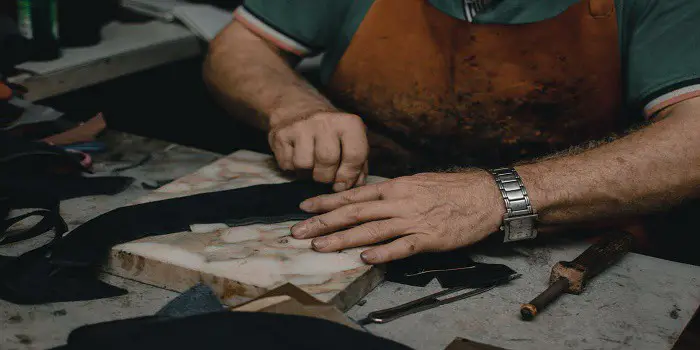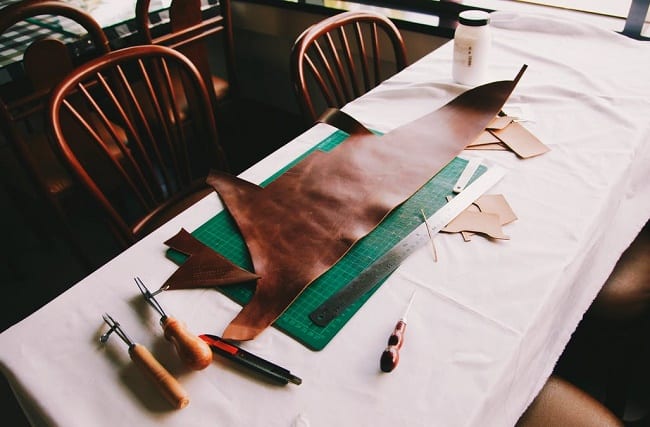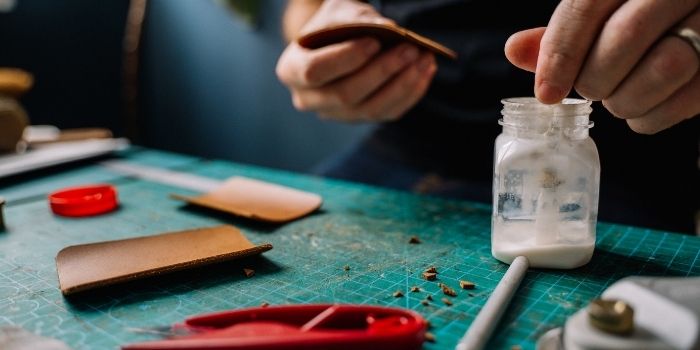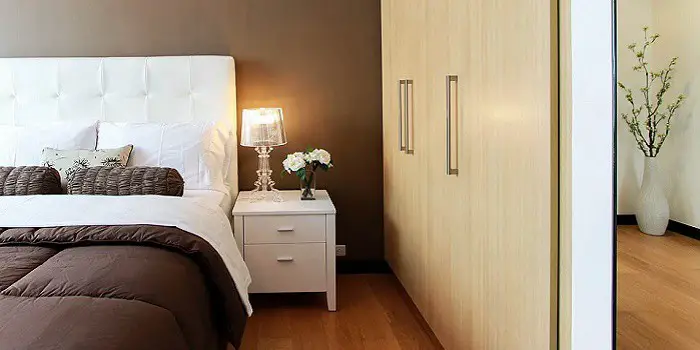
Leather is a flexible yet durable material that has been used for thousands of years for varied projects.
But many feel that it is not suitable for gluing to surfaces like wood because of its weight and also because wood being porous can create complications when using adhesives.
Finding the right glue can, however, do the trick and can get the job done without damaging the substance or appearance of the leather, all while holding its weight.
Gluing Leather to Wood
It takes more than standard glue to adhere leather to wood successfully.
Plus, you will need to follow the steps for prepping the material beforehand for maximum adherence.
The first step is to get a good quality contact cement or glue that is made for both leather and wood.
Once you have that, you are ready to begin.
Step 1: Sand the leather
Use medium-grit sandpaper to sand along the back of the leather.
This will rough up the leather enough, so the nap is in the raised position.
Step 2: Apply cement glue to the leather
Apply a single layer of contact cement to the side of the leather that you have roughed up.
Let it dry for the recommended time or until the contact cement has become tacky.
If you need to apply a second layer, do so as long as it becomes tacky so that it will stick to the wood.
Step 3: Apply contact cement to the wood and attach
Apply a single layer of contact cement to the wood and let it become tacky as well. Be sure that you apply the contact cement to the leather and wood at the same time.
Then place the leather on the wood surface and press them together. Use firm, even pressures until the leather fully sticks to the wood.
One helpful hint is to use a smooth mallet to hammer the leather as the glue is drying.
This will help reinforce the bond developing between the leather and wood surface.

What Glue Works Best for Gluing Leather to Wood?
There are several products that will work well in gluing leather and wood together.
What follows are the recommended products in alphabetical order.
1- Barge All-Purpose TF Cement Glue
This is a general all-purpose glue that offers considerable strength and flexibility.
The glue itself has been in use for over 70 years and remains popular because of its attributes.
Plus, the glue is environmentally friendly and can be used on a wide range of materials.
This makes the glue perfect for adhering leather to wood.
2- Glue Masters Industrial Grade
The resin formula used in this glue consists of Cyanoacrylate or CA, which offers considerable bonding strength.
The overall quality and versatility of this glue are considerable, from gluing leather to wood to repairing broken China and even working on materials in shoes and other items.
The glue itself is thick and strong and will flow evenly for the best adherence to different materials.
3- Loctite Super Glue
One of the most respected names in the industry, Loctite Super Glue has been an industry standard for over a half-century.
The liquid adhesive formula works quite well on both porous and semi-porous materials.
The built-in brush makes it easy to apply, and it has great resistance to temperature changes along with humidity.
This makes it an excellent glue to use on materials that will be exposed to the elements.
4- Gorilla Super Glue Gel
The reputation of Gorilla Glue is considerable, especially because it can dry in as little as 10 to 15 seconds.
Plus, it creates a very strong bond that keeps materials together for a long time.
The Super Glue Gel from Gorilla sets quickly and has a thickness that makes it perfect for gluing different materials together.
There are also no stains because it is clear and dries quickly. You can use it on leather and wood, along with many other types of materials.
This type of glue is also easy to find, so it should be available at most hardware and many retail stores.
5- Titebond III Ultimate Wood Glue
This may be the standard for glue that works well with wood and leather.
It creates a strong bond and has a fast set speed which means less clamping is needed.
One of its major attributes is that the glue is not affected by finishes. It also helps that you can add a thick layer of glue for maximum adhesion.
The glue works well on porous substances such as leather as well as stone, glass, particleboard, hardboard, fabrics, and more.
Even more impressive, you can adjust to the material as the glue sets with relative ease.

How to Pick the Right Glue for Attaching Leather to Wood?
Now that you have the different choices available, you are ready to make your pick.
Keep in mind that there are several highly qualified types of glue, and there are enough differences between them.
So, you should use the following guidelines to choose the best one for your project.
a) Simple to Use
Basically, the fewer issues, the better the glue will be for your project.
You do not want glue that is too thin, too thick, or difficult to pore and place on the materials.
In addition, you want glue that can be stored under room temperature conditions. And for many projects, you want an adhesive that does not have a strong odor.
That may seem like a tall order, but there are many types of glue that have good consistency, are easy to store, and keep the odor to a minimum.
b) Specific to Certain Materials
This can be an easy one to overlook.
Many types of glue will say they are multipurpose, but they may not cover the materials you are trying to bond together.
If you are looking only to glue leather to wood, you should look for glue that does that.
Ensure the materials are included in the package description for the best results. Otherwise, you may find yourself with glue that does not work for what you want.
c) Quality of the Bond
For gluing leather to wood, you will need to use glue that has the right chemicals.
This is because certain chemicals or substances work better than others when gluing leather to wood.
Polyurethane, for example, offers one of the strongest bonds you can find.
If you can find a glue that contains cyanoacrylate, that works quite well with leather and wood.
Such glues are quite versatile, so they not only work well with adhering leather to wood.
They also work with many different materials, including ceramics. That way, you can stretch the usefulness of the glue to different substances over the years.
You should look for cyanoacrylate first when shopping for glues that work well when combining leather and wood.
But that is not the only consideration.
You should check out the instructions on each type of glue to see if it meets other requirements, such as the following.
- Time to Set
- Time to Cure
- Is Clamping Needed?
There is a difference between when glues are set, meaning they can initially hold a bond. And the cure is when the glue is fully dried to its maximum potential.
Short curing times are desired if you are repairing materials for use, so the faster it cures, the faster you can get going.
Be aware that some glues take up to 24 hours to cure while others take over seconds fully.
Clamping may be a requirement with some of the glues, especially if there is a considerable weight difference between the materials.
But you will need to check out all the possibilities.
d) Resistant to the Elements
In other words, can this glue hold up to extreme changes in temperature and moisture?
You may be surprised to learn that some glues will break apart when the temperature stays below freezing for an extended time.
Or that the adhesion will fall apart under extended humid conditions.
If you are going to use glue on items exposed to the elements, then you need to ensure that they are designed for such circumstances.
However, if what you are gluing is going to stay indoors at room temperature, then you do not need to be that concerned.
Brief exposures to changes in temperatures or humidity do not have much of an effect on most types of glues used to bond leather and wood.
e) Cost
Last but not least, how much you pay for the glue should be the final consideration.
Remember that you are not looking for the cheapest glue; you are looking for the best glue at the lowest price.
There is no need to pay more for the right glue when you have many choices available.
Consider that glues that work well on leather and wood tend to be less expensive because the materials themselves are so commonly bonded.
In this case, the price difference may not be all that much, depending on the brands you are considering.
The biggest price difference will be in the strength of the bond itself.
Do you need industrial strength that offers longevity under different environmental conditions?
If so, then you will probably pay a little more for that feature.
However, if the leather and wood you are gluing together are for a project that is small or does not have much weight involved, then a standard consumer glue may be more than enough.
Remember to pay for what you need and not waste money on glues that offer more than what you want.
Final Thoughts
Gluing leather into the wood is hard but not impossible.
To get the job done successfully, ensure that you are using the right adhesive for the right kind of wood.
There are several factors in selecting the suitable glue to attach the leather to the wood.
You will just need to review your specific requirements and search for the correct type of glue to do the job.

Hi, I am Mark Garner a professional carpenter, woodworker, and DIY painter. I live in the small city of Peoria, Arizona as a semi-retired woodworker. I have started this blog with a simple motive to help you with my wood experience in this sector. If you like to know more about what I love doing and how it all got started, you can check more about me here.





